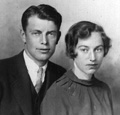|
|

Scott Newhall.
A Newspaper Editor's Voyage Across San Francisco Bay:
San Francisco Chronicle, 1935-1971, and Other Adventures.
1988-1989 | The Bancroft Library, University of California, Berkeley.
|
Scott Newhall led two lives: one in San Francisco, where he was executive editor of The San Francisco Chronicle and ran for mayor in 1971; and one in the Santa Clarita Valley, where his great-grandfather Henry Mayo Newhall planted roots a century earlier. At the same time his fire-and-brimstone editorials in The Chronicle were lighting Bay Area politicians' pants on fire, Scott made hell burn even hotter for the Los Angeles County officials who dared to stand in the way of the Santa Clarita Valley's inevitable autonomy and greatness. Over the course of a quarter-century at the helm, Scott made The Newhall Signal and Saugus Enterprise a family affair, trading off editorial responsibilities with life-partner Ruth Waldo Newhall, bringing two of their sons into the fold, providing both a firm hand and a sense of purpose for an extended family of employees, and supporting a community that supported them in turn. Scott and Ruth's final years at The Signal were frustrating. They'd purchased the paper in 1963 and stayed on after they sold a controlling interest in 1978 to the Morris Newspaper Corp., a small, Georgia-based chain with ideas of its own about profit margins. Scott and Ruth had given up the freedom to make their own back-office decisions. The minute their 10-year noncompete agreement expired in 1988, they marched down the street (Valencia Boulevard) and launched a rival newspaper, the thrice-weekly Santa Clarita Valley Citizen. Loyalists in the news and advertising rooms walked with them; those who needed to put food on the table stayed behind and took The Signal in new and sometimes peculiar directions. The Citizen lasted less than nine months (September 11, 1988 - May 3, 1989), at a loss to Scott and Ruth of about $1.3 million, but its little family of reporters and ad reps would remember it fondly as a gallant rage against the machine. It is against this backdrop that this series of interviews was conducted in 1988 and 1989. The final session took place in the Newhalls' San Francisco apartment. "That day, July 12, 1989, was a great day for my hosts," the interviewer states. "They had just heard that one of their least favorite editors had been asked to leave his post at The Signal. It was a vindication..." (The editor was Chuck Cook, who tended to look for demons within the Santa Clarita Valley rather than outside.) The interviewer is Suzanne Bassett Riess, a lettered journalist and art historian who since 1960 had served as editor in the Bancroft Library's Regional Oral History Office at the University of California, Berkeley, which is the repository for Scott's papers relating to The Chronicle. The primary focus of the interviews is The Chronicle, but Scott has plenty to say about newspapering in general and The Signal in particular, and he takes the interviewer on a trip through many of his life's journeys. This is actually the second set of Scott Newhall interviews. Ruth started interviewing Scott 20 years earlier, in 1967, recording his thoughts and memories on cassette tape. But the tapes burned up when the Newhalls' Piru mansion burned down in February 1981. Scott wasn't thrilled with the first set of interviews anyway. He thought they ran too long. But now, in the late 1980s, "the story had doubled in length," the interviewer writes. Now, "a version of Shangri-la was in place in Valencia, the mansion had been rebuilt within an inch of perfection, and there were new stories to be told."
UC8901: Download individual pages here.
|
SEE ALSO:
Oral History 1988/89
Family Photos x7
World Cruise 1936
Scott, Skip, Tony, Jon 1944
Chronicle x3
Buys Signal 1963
12/23/1965
Anguilla 1967
Scott in England 1969
Eppleton Hall 1970
Pinback: Scott for Mayor 1971
Scott for Mayor 1971
Tony Newhall & Clarion Publisher Jackie Storinsky 1971
Signal Ingot ~1973
Signal 1980s
Silver Spur 1991
Signal Special Edition Upon Scott's Death 1992
Historical Society 2/1993
Video: Ruth Interview 2000
• Ruth Obituary 1
Ruth Tribute 1/2004
|
The site owner makes no assertions as to ownership of any original copyrights to digitized images. However, these images are intended for Personal or Research use only. Any other kind of use, including but not limited to commercial or scholarly publication in any medium or format, public exhibition, or use online or in a web site, may be subject to additional restrictions including but not limited to the copyrights held by parties other than the site owner. USERS ARE SOLELY RESPONSIBLE for determining the existence of such rights and for obtaining any permissions and/or paying associated fees necessary for the proposed use.



















